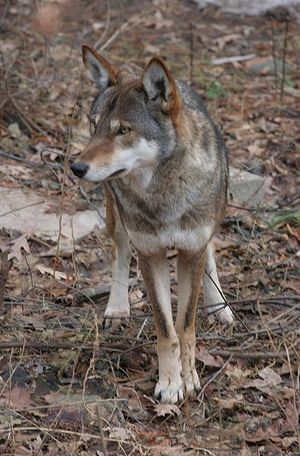Once again, Jack London shocked me with his amazing writing on nature and animals. White Fang is a spectacular book that will leave you begging for more. It is a book on the lives of a generation of wolves, but eventually centers around one wolf, White Fang. He is born into the world in a small cave near a river. London explains the beginning of life in the eyes of a wild cub, and his understanding of physics as an infant. Such as the entrance to the cave is bright, and he thinks that the light is a solid wall, and that he cannot go through it.
After many learning experiences, his mother, Kiche, and him are adopted into an Indian village not far from the cave. Here, White Fang encounters an antagonist that tests his strength and perseverance. His name is Lip-Lip, and up until White Fang out grows his opponent and puts him down, he is the everlasting burden, restricting him from joining in with the other dogs and living a normal life.
White Fang grows into a very strong wolf, but he also develops an unnatural trait for a wild wolf, that is compassion for human kind. Gray Beaver was the Indian tribe leader, and he took a liking to him. Unfortunately, Gray Beaver later is introduced to whiskey, and becomes extremely addicted to it. He even sells White Fang in a desperate attempt to earn enough for more. The buyer was Beauty Smith, an extremely ugly and mean person. While under his rule, White Fang is greatly abused. He is forced to fight to the death with any animal almost every week. He wins every fight, up until a bull dog uses a style White Fang has never seen before. Right before White Fang gets finished off, his future master, Weedon Scott comes to his rescue and stops the dog fight. The two develop a tight bond and go on to have an everlasting friendship to finish out this wonderful story.
This book is the complete opposite of its earlier predecessor, Call of the Wild. Three years after it, London reversed it from a civilized dog learning the ways of the wild wolves, to a pure breed wolf adapting to a more civilized life. I have now read both of the books, and both have stood the test of time to become classics. While reversing, London certainly didn’t let up on the numerous figures of speech that I recognized in both. The entire first page uses imagery to introduce you to the wildness of nature. Such as “The trees had been stripped of frost, and they seemed to lean toward each other, black and ominous, in the fading light.” London gave me enough imagery to understand the areas, but also allowed me to still make my own picture of what I thought they looked like. “Beauty” Smith was a symbol that represented the complete opposite of what he looked like. On the other hand Weedon Scott symbolized good after he rescued White Fang. Several instances of stereotyping also, like how White Fang refers to humans as Gods throughout the entire story. He believes every human has powers extremely better than his. Also while White Fang is competing regularly in fights, the Gods all claimed he was unstoppable, and even nicknamed him The Fighting Wolf. Eventually this stereotype died when White Fang was defeated. Amazing characterization is used by Jack London. Instead of the characters being directly introduced, he tells the tales of two parents, and then White Fang’s slow learning of the world. He wrote in an overall naturistic mood, and in a strong and powerful kind of way. He made White Fang the best he could possibly be, and not anything less.
Several other common figures of speech used in this story. A simile was used on page 270, “…and her arrival was like that of a tornado.” Another one is used when describing how a criminal eats his food in a lonely cell, “…he growled like a wild animal.” While saying that a weasel was much faster than White Fang in his early days, London adds a metaphor, “There was a leap, swifter than his unpracticed sight…” Another metaphor is put in when comparing White Fangs incredible balance, “His feet clung to the earth with the same tenacity that he clung to life.” A metaphor that is referred back to several times is the molding of clay, “This had constituted the clay of him, and it had not been kindly molded by the world.” Irony occurs when White Fang is finally defeated by the pit bull at the peak of his life. I thought for sure he would strike down any animal by the ambitious tone London was writing in. Alliteration is added in the description of Beauty Smith, “For Beauty Smith was cruel in the way that cowards are cruel. Cringing and speech of man…”
While I followed White Fang’s journey through life, I learned many things also. For instance, in the beginning, while wolves were hunting down humans, a single fire kept the wolves away. I did not think just a little fire would keep wolves away during a famine. Actually, I didn’t know that wolves would get within 5 feet of you and not attack… This book took place during the Klondike gold rush, and at the time, London claims that Indians were still living in a natural and non interfered state. I thought the settlers would have ruined their ways long before that… I also never knew that bull dogs were so good at fighting, as it sounds like it was the strongest animal ever born. I learned to make a dog leash to tie a dog in place by using leather and several sticks, and the dog cannot bite it’s way out of it!
I did not learn as much on how to write better though this book, as I have already read several other Jack London books, and taken a lot from him already. But this book does have a few things different than other Jack London’s book. This is the best characterization I have ever read. If I ever write a story in which I can use something close to this, I will definitely try it. The characters and their personalities are focused on a lot more than their actual actions. Up until now, I usually write about what people do and not how they feel or anything inside of them. I suppose I can add a little bit more of personal thoughts into a future story.
Overall I enjoyed White Fang very much, and I suggest anyone who likes animals or nature to come and read it. Once you understand the beginning, the book carries you right through, and the pages will flip faster than you know it!




